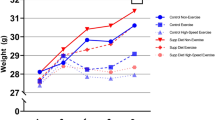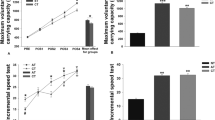Abstract
The effect of treadmill running on the development of osteopenia was investigated in adult ovariectomized (OVX) rats compared with sedentary OVX and sedentary sham-operated rats. The rats were 3 months old with a mean weight of 214 g. OVX rats were fed a low calcium diet (0.01%), and the sham rats received the normal diet (1.1% calcium). The training consisted of treadmill running at a speed of 27 m/minute for 1 hour 5 out of 7 days during a period of 81/2 weeks. The weight gain was higher in the sedentary OVX (108 g) than in the training OVX (62 g) and sham-operated rats (61 g) (P<0.001). Comparing the two OVX groups, training had no significant effects on the development of femoral osteopenia as assessed by mechanical testing of the femoral shaft and neck, and by bone mass measurements by dual energy X-ray absorptiometry (DXA) or by ashing. Comparing all three groups bone mineral content (BMC) and bone mineral density (BMD) were reduced by more than 40% in both the OVX groups compared with the sham-operated rats (P<0.001). Ash weight and calcium content were reduced by approximately 40% in both OVX groups. Femoral volume and length were 10% higher in the sedentary OVX animals compared with the trained (P<0.05), indicating that the training had had a negative effect on the growth changes induced by ovariectomy. The fracture strength of the femoral shaft was reduced by 26% and 22% in the trained and sedentary OVX rats, respectively compared with the sham-operated group (P<0.001). The fracture strength of the femoral neck was reduced by 18% and 15% but due to one very weak neck in the sham group, this difference was not significant. The accuracy of BMC measured by DXA was high when compared with calcium content (r=0.98, P<0.001) and ash weight (r=0.96, P<0.001). DXA underestimated the BMC of the femur by 27% as compared with ash weight. BMC was also highly correlated to fracture strength of the shaft (r=0.85, P<0.001), but not to fracture strength of the neck. This study shows that high intensity training had no positive effect on the development of osteopenia in rats, and we have also validated and found DXA to be a precise and useful tool for experimental studies on osteoporosis in the rat.
Similar content being viewed by others
References
Sinaki M (1989) Exercise and osteoporosis. Arch Phys Med Rehabil 70:220–229
Dalén N, Olsson KE (1974) Bone mineral content and physical activity. Acta Orthop Scand 45:170–174
Smith EL, Gilligan C, McAdam M, Ensign CP, Smith PE (1989) Deterring bone loss by exercise intervention in premenopausal and postmenopausal women. Calcif Tissue Int 44:312–321
Martin D, Notelovitz M (1993) Effects of aerobic training on bone mineral density of postmenopausal women. J Bone Miner Res 8:931–936
Heikkinen J, Kurttila ME, Kyllonen E, Vuori J, Takala T, Vaananen HK (1991) Moderate exercise does not enhance the positive effect of estrogen on bone mineral density in postmenopausal women. Calcif Tissue Int 49:S83-S84
Prince RL, Smith M, Dick IM, Price RI, Webb PG, Henderson NK, Harris MM (1991) Prevention of postmenopausal osteoporosis. A comparative study of exercise, calcium supplementation, and hormone-replacement therapy. N Engl J Med 325: 1189–1195
Pruitt LA, Jackson RD, Bartels RL, Lehnhard HJ (1992) Weight-training effects on bone mineral density in early postmenopausal women. J Bone Miner Res 7:179–185
Sinaki M, Wahner HW, Offord KP, Hodgson S (1989) Efficacy of nonloading exercises in prevention of vertebral bone loss in postmenopausal women: a controlled trial. Mayo Clin Proc 64: 762–769
Drinkwater B, Nilson K, Chesnut CH, Bremner WJ, Shainholtz S, Southworth MB (1984) Bone mineral content of amenorrheic and eumenorrheic athletes. N Engl J Med 311:277–281
Wolman RL, Clark P, McNally E, Harries M, Reeve J (1990) Menstrual state and exercise as determinants of spinal trabecular bone density in female athletes. Br Med J 301:516–518
Nordsletten L, Kaastad TS, Skjeldal S, Kirkeby OJ, Reikerås O, Ekeland A (1993) Training increases the in vivo strength of the lower leg: an experimental study in the rat. J Bone Miner Res 8:1089–1095
Li KC, Zernicke RF, Barnard RJ, Li AF (1991) Differential response of rat limb bones to strenuous exercise. J Appl Physiol 70:554–560
Raab DM, Smith EL, Crenshaw TD, Thomas DP (1990) Bone mechanical properties after exercise training in young and old rats. J Appl Physiol 68:130–134
Raab DM, Crenshaw TD, Kimmel DB, Smith EL (1991) A histomorphometric study of cortical bone activity during increased weight-bearing exercise. J Bone Miner Res 6:741–749
Woo SLY, Kuei SC, Amiel D, Gomez MA, Hayes WC, White FC, Akeson WH (1981) The effect of prolonged physical training on the properties of long bone: a study of Wolff's law. J Bone Joint Surg [Am] 63-A:780–787
Forwood MR, Parker AW (1987) Effects of exercise on bone growth: mechanical and physical properties studied in the rat. Clin Biomech 2:185–190
Forwood MR, Parker AW (1991) Repetitive loading, in vivo, of the tibiae and femora of rats: effects of repeated bouts of treadmill running. Bone Miner 13:35–46
Grundnes O, Reikerås O (1992) Effects of function on rat femora. Acta Orthop Scand 63:70–73
Hou JC, Salem GJ, Zernicke RF, Barnard RJ (1990) Structural and mechanical adaptations of immature trabecular bone to strenuous exercise. J Appl Physiol 69:1309–1314
Tuukkanen J, Peng Z, Väänänen HK (1991) Effect of exercise on osteoporosis induced by ovariectomy in rats. Calcif Tissue Int 49:S80
Puustjärvi K, Karjalainen P, Nieminen J, Arokoski J, Parviainen M, Helminen HJ, Soimakallio S (1992) Endurance training associated with slightly lowered serum estradiol levels decreases mineral density of canine skeleton. J Bone Miner Res 7:619–624
Bourrin S, Zerath E, Vico L, Milhaud C, Alexandre C (1992) Bone mass and bone cellular variations afte five months of physical training in rhesus monkeys-histomorphometric study. Calcif Tissue Int 50:404–410
Pohlman RL, Darby LA, Lechner AJ (1985) Morphometry and calcium contents in appendicular and axial bones of exercised ovariectomized rats. Am J Physiol 248:R12-R17
Donahue HJ, Mazzeo RS, Horvath SM (1988) Endurance training and bone loss in calcium-deficient and ovariectomized rats. Metabolism 37:741–744
Barengolts EI, Curry DJ, Bapna MS, Kukreja SC (1993) Effects of 2 non-endurance exercise protocols on established bone loss in ovariectomized adult rats. Calcif Tissue Int 52:239–243
Yeh JK, Liu CC, Aloia JF (1993) Additive effect of treadmill exercise and 17-beta-estradiol replacement on prevention of tibial bone loss in adult ovariectomized rat. J Bone Miner Res 8:677–683
Barengolts EI, Curry DJ, Bapna MS, Kukreja SC (1993) Effects of endurance exercise on bone mass and mechanical properties in intact and ovariectomized rats. J Bone Miner Res 8:937–942
Waynforth HB (1980) Experimental and surgical technique in the rat. Academic Press Inc. Ltd, London
Kalu DN, Liu CC, Salerno E, Hollis B, Echon R, Ray M (1991) Skeletal response of ovariectomized rats to low and high doses of 17 beta-estradiol. Bone Miner 14:175–187
Kirkeby OJ, Berg LT (1991) Regional blood flow and strontium-85 incorporation rate in the rat hindlimb skeleton. J Orthop Res 9:862–868
Engesæter LB, Ekeland A, Langeland N (1978) Methods for testing the mechanical properties of the rat femur. Acta Orthop Scand 49:512–518
Nordsletten L, Ekeland A (1993) Muscle contraction increases the structural capacity of the lower leg: an in vivo study in the rat. J Orthop Res 11:299–304
Ekeland A, Engesæter L, Langeland N (1981) Mechanical properties of fractured and intact rat femora evaluated by bending, torsional and tensile tests. Acta Orthop Scand 52:605–613
Gürkan L, Ekeland A, Gautvik KM, Langeland N, Rønningen H, Solheim LF (1986) Bone changes after castration in rats. A model for osteoporosis. Acta Orthop Scand 57:67–70
Kalu DN (1991) The ovariectomized rat model of postmenopausal bone loss. Bone Miner 15:175–191
Madsen JE, Almaas R, Nordsletten L (1993) Larger strength reduction in the femoral neck than in the shaft after ipsilateral tibial fracture in the rat. Trans Eur Orthop Res Soc 3:10
Griffin MG, Kimble R, Hopfer W, Pacifici R (1993) Dual-energy X-ray absorptiometry of the rat-accuracy, precision, and measurement of bone loss. J Bone Miner Res 8:795–800
Hagiwara S, Lane N, Engelke K, Sebastian B, Kimmel DB, Genant HK (1993) Precision and accuracy for rat whole body and femur bone mineral determination with dual X-ray absorptiometry. Bone Miner 22:57–68
Cohen B, Laskey MA, Phil D, Rushton N (1993) Accuracy and precision of bone mineral analysis of the rat femur by dualenergy X-ray absorptiometry. Calcif Tissue Int 52:S157
Nordsletten L, Kaastad TS, Skjeldal S, Reikerås O, Nordal KP, Halse J, Ekeland A (1994) Fracture strength prediction in rat femoral shaft and neck by single photon absorptiometry of the femoral shaft. Bone Miner 25:39–46
Myers ER, Hecker AT, Rooks DS, Hipp JA, Hayes WC (1993) Geometric variables from DXA of the radius predict forearm fracture load in vitro. Calcif Tissue Int 52:199–204
Sommer HM (1987) The biomechanical and metabolic effects of a running regime on the Achilles tendon in the rat. Int Orthop 11:71–75
Forwood MR, Parker AW (1986) Effects of exercise on bone morphology. Vascular channels studied in the rat tibia. Acta Orthop Scand 57:204–207
Grundnes O, Reikerås O (1991) Mechanical effects of function on bone healing. Nonweight bearing and exercise in osteotomized rats. Acta Orthop Scand 62:163–165
Saville PD, Whyte MP (1969) Muscle and bone hypertrophy. Positive effect of running exercise in the rat. Clin Orthop 65: 81–88
Author information
Authors and Affiliations
Rights and permissions
About this article
Cite this article
Nordsletten, L., Kaastad, T.S., Madsen, J.E. et al. The development of femoral osteopenia in ovariectomized rats is not reduced by high intensity treadmill training: A mechanical and densitometric study. Calcif Tissue Int 55, 436–442 (1994). https://doi.org/10.1007/BF00298557
Received:
Accepted:
Issue Date:
DOI: https://doi.org/10.1007/BF00298557




